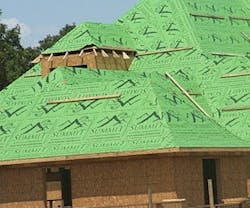SUMMIT Synthetic Underlayment by Atlas Roofing Corporation
Designed for steep-slope roof applications, SUMMIT is made from an inorganic, lightweight, and strong woven polypropylene that’s coupled with UV and water resistive coatings.
The underlayment can be exposed to water and sunlight for up to six months to protect your building throughout the roofing project. It’s compatible with asphalt shingles, metal roof coverings, clay and concrete tile, slate, wood shingles and shakes, or any other code-approved covering for steep-slope roofs.
SUMMIT also carries a UL classification demonstrating its compliance with fire testing requirements.





